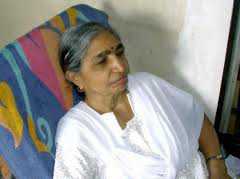The Right to Choose: Family Lessons

Far from a generational divide, the author, as a young feminist, finds sustenance in the ways the women in her family handled their more limited life choices.
It’s hard for me to imagine what my grandmother’s youth was like, spent in rural and then urban India. At 16, she was arrange-married to a man she had met once years before, at 17 pregnant with her first child, by 21 the mother of three young children. There are few pictures of her from that time, so I’ve made them up for myself; Baa on her wedding day in hot, heavy clothes; Baa working in the green fields through her first pregnancy, chewing ginger for strength; Baa with another baby in her arms, cooking dinner for her family.
I had been thinking of her when I first read in the New York Times about a perceived generational divide in feminist responses to the Stupak amendment (“In Support of Abortion, it’s Personal v. Political”). Feminists who remembered a time when abortion was illegal expressed an urgency to take action that they felt was lacking in later generations. Sheryl Gay Stolberg wrote that long-time feminists like NARAL Pro-Choice President Nancy Keenan tend to view reproductive choice “in stark political terms—as a right to be defended, like freedom of speech or freedom of religion.” A later blog post for Newsweek quoted University of Maryland assistant professor Kristy Maddux, who specializes in historical feminism, saying younger women “don’t have any reason to believe that it matters if they go out and protest. Instead, they talk about their positions to friends and neighbors.”
In these discussions, I am caught again and again by the word “choice,” referring to a woman’s right to choose to have an abortion, and in a larger sense, to afford to women the same choices and freedoms as men. My grandmother, as a young woman, had few choices. She could not choose to stay single or childless or not work to support her family. And yet, she managed to change her life by staying in school—while many of her peers dropped out when they got married—and even made it through college. Years later, my mother also made a choice that she was not allowed to make when she enrolled in a prestigious engineering school in India where the student body was less than one percent female. And now, like other women in my generation, I am the beneficiary of the struggle of their choices, standing in front of so many more open doors.
It’s a temptation to say that too many choices have left young feminists apathetic, an unwritten implication hovering over these articles. I sometimes long for my understanding of what the sixties was like—a time when movements and marches were overwhelming and effective, and issues were urgent and full of moral certainty. Now, yes, we must fight for reproductive rights, but also for same sex marriage, and against global warming and the war in Darfur—all complicated and inextricably linked. Like activists who came before us, we must make the hard choice of which issues are the most urgent; while the idea of a feminist movement, or what it means to be a feminist, seems more fractured every day.
How do we measure a generation’s apathy? It’s true that many young people have, until the Stupak Amendment, taken reproductive rights for granted—more than 30 years have gone by since Roe v. Wade. And access to abortion has never come so directly under attack on a national level (though, of course, many women still face challenges in exercising this right, Stupak or no). Many older feminists do find young people in their ranks. “What's becoming increasingly clear is that there are young, energetic feminists committed to fighting for equality for women,” observes Feministing.org blogger Karen. “Maybe younger feminists want to form their own organizations rather than build those that emerged from second wave feminism. Maybe they'll do both.”
I baffle my mother with my inability to make small decisions; what to order at a restaurant, whether or not to buy a new blender. Her decisions are careful and she makes them without doubt or regret. When she was growing up, she tells me, it was easy to choose what dress to wear in the mornings—she only had three. Our decisions get tougher with more options. But the world will not sit still while we choose which way we will enter it to fight. With minute to minute updates, blog posts, YouTube videos, Twitter feeds, we can see horrors unspooling before our eyes if we look in the right places. We can hear always the voices of those who have come before us, choose something, choose quickly, choose now.
So what do we, as young feminists, owe to ourselves—and to the activists who fought for the choices we now can enjoy without thinking? What kind of choices do we want to leave behind for future generations? I can’t answer these questions for anyone but myself, yet it’s important to keep asking them. And the choice of what, how and when to fight, far from making us apathetic, can embolden us and widen our impact. If we are taking to the net as well as the street, if we are making the quiet choices as well as the loud ones, if we are engaging personal issues as well as global ones, well, we are choosing. We are answering the question—lucky us!—as a resounding “yes.” We will choose, and choose again, so that more people can have more choices. We choose everything.
More articles by Category: Feminism, Race/Ethnicity
More articles by Tag: Reproductive rights



























